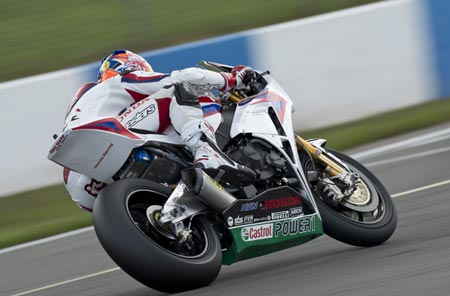World Superbike
Almost 25 years ago, when World Superbike first started, the machinery was pretty much showroom-standard 750 cc four cylinders and 851 cc twins. When 500 cc Grand Prix bikes had 50% more power than a superbike, 120 bhp was very respectable from an exotic four-stroke 750 cc four-cylinder such as a Yamaha OW-01 or a Honda RC30. The latest World Superbikes are still based on production machinery, but are highly specialised, and much closer to Grand Prix machinery in terms of power and lap time than was the case in the early days.
The Honda World Superbike Team has campaigned a pair of Fireblades in the 2012 World Championship, ridden by Hiroshi Aoyama and Jonathan Rea. The team’s technical coordinator Pieter Breddels answered some questions regarding the Honda’s exhaust requirements. In terms of performance development when working toward a new exhaust system design, Breddels stated that consistency is important. Keeping pipe lengths as equal as possible means the tuning behaviour for each cylinder is the same. Experimenting with different pipe diameters and testing what is best for performance is also important. Exhaust packaging, whether for a car or bike, is often a compromise, since fitting in the pipe sizes and bend radii that you would like to use is not always possible.
Exhaust system mass is an important consideration and, in common with many race motorcycle exhausts, the team uses a full titanium system. Bike exhausts are well supported, so titanium can provide sufficient longevity. Breddels comments, “We think a life of 1500 km is acceptable.” Previously, stainless steel had been used for the headers (primary pipes) but the weight of the system was deemed to be “a problem”. The aim of using stainless steel in the past was to improve reliability, but with careful design and manufacture, the longevity of the titanium system has improved to the point where the heavier material is no longer required.
There are strict regulations in World Superbike concerning noise, and the titanium silencers need to be replaced before the 1500 km limit, but this is only for the silencer (muffler) to be re-packed to maintain its noise attenuation. It is typical for a silencer with packing to become noisier over time; some of the material is lost, escaping through the perforations via which the pressure waves ‘percolate’ into the packing. The rest either degrades, becomes compressed or contaminated.
While many superbike aftermarket exhaust systems use ‘link pipes’ or ‘balance pipes’ to link primary pipes to each other, the Honda World Superbike Team finds no requirement for these, with the exhaust system working well enough over the working range without them. Such link-tubes can help fill in holes in the torque curve or smooth power delivery, although this is often to the detriment of the power curve elsewhere. They also represent a reliability risk, as the slip joints, if not perfectly aligned, put stress into the exhaust system and in particular the welds.
The Honda system is a 4-2-1 configuration, with pairs of primaries joining together before the resulting two pipes are then joined ahead of the silencer.
In recent years there has been a real trend for silencers to be placed lower on the bike and for the system to be shorter. Gone are the days of large, high-mounted silencers alongside the rear wheel. The silencer on the Honda begins only just rearward of the swing-arm pivot and, as can be seen from Fig. 1, starts inside the fairing.

Fig. 1 - The Honda World Superbike Team achieves a winning combination of low system mass, longevity and performance from its titanium exhaust system (Courtesy of Honda)
Written by Wayne Ward